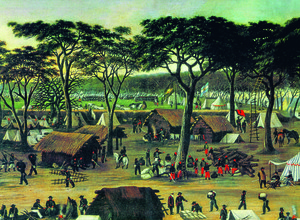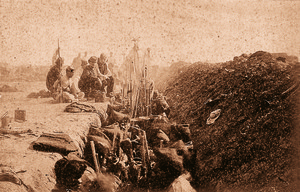
Reproduction from the book Maldita Guerra/oil on canvas by Candido Lopez, 1891
View of the inside of Curuzú, September 20, 1866Reproduction from the book Maldita Guerra/oil on canvas by Candido Lopez, 1891Tolstoy was sadly right when he wrote that a happy nation has no history. Hence the reminder to people that they have a reason to be unhappy and that it is necessary to “remedy” the past. “Brazil has a historical debt with Paraguay, which can be paid off by granting it special treatment in relations between the two countries. In the case of Itaipu, Brazil should pay the market price – and not the cost price, as established in the partnership” for the surplus electric power that Paraguay does not consume.” These words were voiced during an interview with the newly-elected President of Paraguay, Fernando Lugo, who was invoking, in the name of current issues, the distant Paraguay War (1865-1870). “President Hugo Chávez reminded President Lugo of his admiration for the historical battle of the Paraguayan nation, the heroic heir to the legacy of general Francisco Solano López, and they agreed on the need to continue building the Union of South American nations on the basis of the war history of our nations,” states the communication issued by the Venezuelan Foreign Office concerning Chávez’s telephone call to his newly-elected colleague.
“López was a great Latin American patriot, who had been humiliated by the alliance of the triple betrayal of Latin America, its men and its women,” said Argentine President Cristina Kirchner when she christened a unit of the Argentine army in honor of López. The notion of the “historical debt” is also voiced by Brazilians, such as Senator Cristovam Buarque, who advocates that changes must be made to the Itaipu agreement: “We cannot simply deny Paraguay the right to ask for the adjustment. We cannot ignore Paraguay. We are in debt to our neighboring country, because 138 years ago we killed 300 thousand Paraguayan citizens during the War with Paraguay. Proportionally, it would be as if they had killed 9 million Brazilians.” Dictators such as Stroessner and militant leftists have long been united in their condemnation of the War with Paraguay, referring to it as an “imperialist massacre” by Brazil, in alleged conspiracy with England, which devastated the chances of Paraguayan greatness or, in the words of Lugo: “There is recognition of the historical debt to Paraguay. We believe in Justice and Paraguay should go back to the status it held in the past, that of a more developed and united country with a special economic project.”
Thus, no matter how unlikely it might sound, the present is a great time to go back and talk about the key characters of this ancient battle. A good example is the new biography of general Osório (General Osório, published by Companhia das Letras, 262 pages, R$ 35.50), launched on the bicentennial of the general’s birth. The book was written by historian Francisco Doratioto, the author of Maldita guerra, uma história revisionista da Guerra do Paraguai [Accursed was, a revisionist history of the Paraguay War], which topples myths such as the extermination of Paraguay’s male population, López’s modernizing ideals and the victimizing of Paraguay. “Anyone who talks about betrayal is either poorly informed or has covert intentions. López was the attacker who invaded the neighboring countries. There was no such thing as Paraguayan industrialization and Paraguay never had the alleged golden age. López was not a paradigm of progress nor of the struggle against imperialism, neither was he a builder of modern societies,” he explains. “Argentine and Uruguayan revisionism was left-leaning, and Paraguayan revisionism was right-wing nationalism that sought to legitimize a dictator such as Stroessner by resorting to the figure of another dictator, López.” History was not well served in either case. “In Paraguay, the hero worshipping of López served the dictatorship; in Brazil, the reference to the war and to the Brazilian army as diabolic served as a weapon to fight the dictatorship,” as José Murilo de Carvalho wisely pointed out.

Reproduction from the book General Osório, iconography collection
Brazilian army landing in ParaguayReproduction from the book General Osório, iconography collectionMisguided beliefs regarding the true dimensions of the conflict and of the characters involved in it, however, are not limited only to commercial interests or political opportunism. Osório, who was the commander of the Brazilian Army in Paraguay, has also been affected by this disingenous rewriting of history. “The Army of Caxias, as this institution is currently referred to, was for a long time referred to as the Army of Osório. This change can only be understood if the political and military histories of the two generals are put within the historical context in which they were adopted as paradigms,” says Doratioto. “After all, although they are now remembered as military men, they were also politicians and, at a certain point in time, dedicated themselves much more to politics than to the Army.” Caxias, a member of the Conservative Party, was elected Senator on a political platform that advocated a centralizing State and maintaining the social order. Osório was from the Liberal Party, whose political platform prioritized decentralized power and more active participation of citizens in the political process. Caxias was a member of the Army elite, having graduated from the Academy, whereas Osório came from the foot soldiers’ Army that wanted to upgrade its social standing (in his old age, Osório confessed that he detested military life); this lowly Army overlooked minor transgressions, formalism and appearances. This is why the young Republic, which stemmed from a military coup and was devoid of symbolism, says Doratioto, had to discover a “pre-republican” element in Osório, to the extent that in 1894, Floriano Peixoto organized a march to inaugurate the statue of the general in Rio de Janeiro, in what is today the Praça XV square.
“He was the first Brazilian general to step on Paraguayan territory and while Caxias and other Brazilian military men and politicians mistrusted the Argentine president, Mitre (the leader of the Triple Alliance against Paraguay), stating that Mitre was acting to prolong the conflict, whether because of financial gains that it brought Argentina or whether to weaken the Brazilian Empire, Osório was one of the few Brazilian military officers who didn’t share this feeling,” states Doratioto. British adventurer Richard F. Burton, then the British consul in Santos and a British observer of the war, reported that the soldiers admired Osório and believed that “he was protected from all evil by the gods; after a battle, he would allegedly shake his poncho to shake out the bullets.” The general’s colleagues viewed him as being “irresponsible” because of the way he risked his life during combat. At the Battle of Avaí, a gunshot destroyed his jawbone, but later on, after having been substituted by Count d’Eu at the head of the troops, he did not shirk his duty and went back to the front to fight.
During the attack on the fortress of Humaitá, Lopéz’ main defense outpost, Osório was sent by Caxias to check the success of the bombarding of the river conducted by the allied squadron. Confronting resistance, he stated that he had received orders from Caxias to retreat (Caxias never confirmed that he had given such an order), provoking heavy losses. “This episode left some open wounds, which were exploited by the liberals, who began to refer to Osório as a victim of Caxias, because the latter viewed Osorio as being a rival,” says the author. The author points out that, at the end of the war, “Osório was by far the most popular person in Brazil, with the exception of Emperor Pedro II; this was an uncomfortable fact for the conservative administration.” It is therefore easy to understand why, for four decades, the main military celebration was held on the date of the Battle of Tuiuti, where Osório was the hero of the day. It is harder to understand why the General was “demoted” in the 1920s, and Caxias – who up to then was a secondary character – was upgraded to the post of Patron of the Army.

Reproduction from the book Maldita Guerra
The Trenches of Tuiuti, the battle of April 24, 1866Reproduction from the book Maldita GuerraReinvention
“In contrast to the ‘forgetting’ of Caxias, Osório was celebrated as a great military general – this was a spontaneous cult,” says historian Celso Castro, in whose opinion the reasons for this change lie in the Army’s concern with the rebellious actions of the “rebellion of lieutenants” that led to the Revolution of 1930. “More than the reorganization of a fragmented institution, the Army was reinvented as a national institution, the heir to a specific tradition with a role to play in the construction of the Brazilian nation,” says Castro. To this end, it was necessary to “invent” a Caxias that was more aligned with the new symbolic role required. “The characteristics ascribed to Caxias – that he was a disciplined and non-political general – are part of this image created in the twentieth century, in compliance with the interests of a national, conservative Republic, which was making an effort to contain military unrest. These characteristics, however, describe a ‘military being’ that didn’t exist in the nineteenth century,” analyzes historian Adriana Barreto de Souza, who did her doctoral thesis on Caxias and the formation of the Brazilian Empire. “Enthroned in this pantheon and, after 21 years of a military dictatorship, the dialogue with Caxias became more difficult, because he was either treated with unrestricted admiration by the military, or demonized as the Patron of the Army by the opposition to the military coup of 1964. He became the ‘monument duke,'” says Adriana.
Though replacing Osório by Caxias was at first a way to enhance legality and establish some distance from politics, as at the time of Vargas’ Estado Novo [New State] regime, this change, though upheld, began to take on new tones: “They started to emphasize the duke’s qualities as a military commander at the service of a strong, centralized State, such as that of the Vargas dictatorship,” says Doratioto. This instrumental attitude persisted after 1964, when the military that came to power stressed those characteristics of Caxias that were of interest to the situation at the time, as exemplified by the repression of revolutionary movements. “These were indeed his traits and, with the exception of the principle of centralization, were those of Osório as well. However, the two generals also shared the following characteristics: subordination to civil power, an aversion to dictatorships, and rejection of militarism; but the ideologues of authoritarianism had no interest in reviving these traits and the ideologues of democracy were negligent about restoring them.” Unfortunately, it is sometimes more convenient to forget the words of Tolstoy and the replace them with Bismarck’s pragmatism: “History is merely a printed piece of paper; it is important to make history rather than to write it.”
Republish